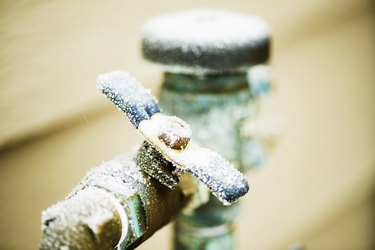They are making a few good annotation regarding Winter Plumbing Precautions: Preventing Frozen Pipes as a whole in the article further down.

Winter can wreak havoc on your plumbing, specifically by freezing pipelines. Below's how to prevent it from occurring and what to do if it does.
Introduction
As temperature levels drop, the danger of frozen pipelines rises, potentially causing costly repairs and water damages. Comprehending how to avoid frozen pipelines is critical for property owners in chilly climates.
Recognizing Icy Pipes
What triggers pipelines to freeze?
Pipelines freeze when exposed to temperatures listed below 32 ° F (0 ° C) for expanded periods. As water inside the pipes ices up, it broadens, taxing the pipeline walls and potentially creating them to burst.
Risks and damages
Frozen pipes can bring about water system interruptions, residential property damage, and costly repair work. Ruptured pipelines can flood homes and trigger extensive architectural damages.
Indications of Frozen Piping
Identifying frozen pipes early can avoid them from rupturing.
Just how to recognize icy pipes
Seek decreased water circulation from taps, unusual smells or sounds from pipelines, and noticeable frost on subjected pipes.
Avoidance Tips
Insulating prone pipes
Cover pipelines in insulation sleeves or make use of warmth tape to secure them from freezing temperatures. Focus on pipelines in unheated or outside locations of the home.
Home heating strategies
Maintain interior areas properly warmed, specifically locations with pipes. Open closet doors to permit cozy air to circulate around pipes under sinks.
Protecting Outdoor Pipes
Yard tubes and exterior faucets
Separate and drain pipes garden hose pipes before winter season. Mount frost-proof spigots or cover exterior taps with insulated caps.
What to Do If Your Pipelines Freeze
Immediate activities to take
If you think frozen pipelines, maintain faucets open up to eliminate stress as the ice melts. Utilize a hairdryer or towels soaked in hot water to thaw pipelines gradually.
Long-Term Solutions
Structural adjustments
Consider rerouting pipelines far from outside walls or unheated areas. Add added insulation to attics, basements, and crawl spaces.
Upgrading insulation
Buy high-grade insulation for pipes, attics, and walls. Correct insulation helps maintain consistent temperature levels and reduces the danger of icy pipelines.
Conclusion
Stopping icy pipelines needs positive steps and quick actions. By comprehending the reasons, indicators, and safety nets, property owners can safeguard their plumbing throughout cold weather.
5 Ways to Prevent Frozen Pipes
Drain Outdoor Faucets and Disconnect Hoses
First, close the shut-off valve that controls the flow of water in the pipe to your outdoor faucet. Then, head outside to disconnect and drain your hose and open the outdoor faucet to allow the water to completely drain out of the line. Turn off the faucet when done. Finally, head back to the shut-off valve and drain the remaining water inside the pipe into a bucket or container. Additionally, if you have a home irrigation system, you should consider hiring an expert to clear the system of water each year.
Insulate Pipes
One of the best and most cost-effective methods for preventing frozen water pipes is to wrap your pipes with insulation. This is especially important for areas in your home that aren’t exposed to heat, such as an attic. We suggest using foam sleeves, which can typically be found at your local hardware store.
Keep Heat Running at 65
Your pipes are located inside your walls, and the temperature there is much colder than the rest of the house. To prevent your pipes from freezing, The Insurance Information Institute suggests that you keep your home heated to at least 65 degrees, even when traveling. You may want to invest in smart devices that can keep an eye on the temperature in your home while you’re away.
Leave Water Dripping
Moving water — even a small trickle — can prevent ice from forming inside your pipes. When freezing temps are imminent, start a drip of water from all faucets that serve exposed pipes. Leaving a few faucets running will also help relieve pressure inside the pipes and help prevent a rupture if the water inside freezes.
Open Cupboard Doors
Warm your kitchen and bathroom pipes by opening cupboards and vanities. You should also leave your interior doors ajar to help warm air circulate evenly throughout your home.

We had been made aware of that report about 6 Ways to Prevent Frozen Pipes through a good friend on our other site. So long as you liked our page if you please remember to pass it around. We truly appreciate reading our article about Prevent Frozen Pipes .
Call Today
Comments on “Avoiding Frozen Plumbing in Cold Weather: Pro Tips”